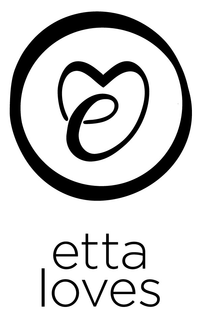EASY SENSORY PLAY IDEAS
We exist to make your life that bit easier and your baby's life even more mesmerizing. So here are some simple but very effective ways to engage your little one in sensory play. Using your favourite Etta Loves products along with some household objects like wooden spoons and empty loo roll, they will provide precious connection time, as well as help support their visual, social, cognitive and motor skills development.

1. PLAYMAT PROP
THE ACTIVITY: Prop your sensory playmat up against the side of the sofa, over a pillow or your diaper bag, so baby can take in the patterns when lying on their back. Make sure to alternate sides.
THE SCIENCE: Encouraging head turning will help with both the rounding of their head and the strengthening of their neck muscles whilst the clever prints provide perfect visual and cognitive support.
2. FACE OFF
THE ACTIVITY: Get down close to your baby, pull some funny faces and watch to see if baby mimics you. Use the mirror on our sensory hanging squares to show their reflection too, faces are their favourite thing to look at!
THE SCIENCE: Babies love faces as they know that people are what keep them alive. They can also mimic the faces we pull from a very young age, especially poking your tongue out . During tummy time, putting a mirror in front of them can encourage babies to lift and keep their head up.
3. LISTEN UP
THE ACTIVITY: Find the ‘crinkle’ and ‘rattle’ sensory hanging squares and let your baby listen to the noises. If they are older, they’ll enjoy holding the squares too.
THE SCIENCE: The sounds help stimulate baby’s brain activity and if they are holding the squares it supports their gross motor skills. The creation of sounds through movement also support them learning about cause and effect.
4. PLAYFUL PATTERNS
THE ACTIVITY: Hold a sensory muslin about 20cm from baby’s face and watch them lock onto the print and become mesmerised. Switch it up after 30 seconds or so and alternate with a different, perfectly scaled printed muslin to keep them engaged in different pattern types.
THE SCIENCE: Patterned surfaces are more neurally stimulating than plain surfaces, and in fact babies need pattern input to learn about the world.
5. HIDE & SEEK
THE ACTIVITY: Let baby watch as you push a sensory lovey into an empty toilet roll tube and then pull it out again. This will help them learn that things still exist, even when they can’t be seen. Older babies can be encouraged to pull the comforter out from the tube for added sdevelopmental support.
THE SCIENCE: ‘Object permenance’ is the understanding that just because something has disappeared, it doesn’t mean it’s gone forever. Babies discover this from around 4 months old and it support them not getting upset when you leave the room or tidy something out of sight.
6. DEN DELIGHT
THE ACTIVITY: Hide together under a sensory muslin and watch their reaction as you play together and engage with the patterns.
THE SCIENCE: Getting down and close with them helps them enjoy being near, they will love seeing their favourite face and appreciate the patterns along with change in light level.
7. SENSORY SNAKE
THE ACTIVITY: Tie your sensory muslins together to make a snake and wiggle it around the room. If they’re older, tie it to a wooden spoon and let them have a bash on a hard surface, like a saucepan.
THE SCIENCE: Babies don’t have binocular or 3D vision until around 4 months old, so their sense of the world is rather inaccurate with the brain receiving 2 separate images from their eyes, but not being able to process it into one single image like we do as adults. This means we need to move things more slowly when they’re little, speeding things up gradually as they develop.
8. SIDE TO SIDE
THE ACTIVITY: Hold a sensory hanging square about 20cm from baby’s face so they can see the pattern. Slowly move it from side-to-side ensuring thier eyes are following it, then swap patterns to a different square.
THE SCIENCE: By about 3 months old, most babies can visually track objects. This is the ability to follow moving objects with the eyes without moving the head. This eye control is a fine motor skill that includes eye movement from side to side and up to down, as well as diagonal and circular movement. Mastering visual tracking sets the stage for your child’s success in reaching future visual milestones.
9. SCENTSORY
THE ACTIVITY: Secure a bag of lavender, fresh herbs or anything pleasant smelling into the centre of your sensory muslin and let baby enjoy the exciting new scent.
THE SCIENCE: The olfactory (smell) receptors begin to develop as early as 8 weeks gestation and become fully functional at about 24 weeks. This means that your baby is born with a completely developed sense of smell. Within the first few days they will show a preference for the smell of their own mother.
10. PEEKABOO
THE ACTIVITY: Play peekaboo with a sensory muslin to make them giggle. Either hide yourself then uncover, or hide them by pulling it down from their face to their toes with a happy peekaboo when you or they are revealed.
THE SCIENCE: Babies have to learn object permanence - that just because something disappears it doesn’t mean it isn’t coming back. It develops naturally around 4 months old and it’s important for them to understand this so that you can leave a room without them being distraught. Learning through play is one of the best ways to teach this.
11. KICK ABOUT
THE ACTIVITY: Space blankets are a great, multi-use sensory item that babies love. Crinkle up a foil space blanket and put it near or under your baby’s feet and legs. They will love kicking their legs and listening to the noise it makes, helping them start to understand cause and effect.
THE SCIENCE: Foil blankets in sensory play are great for developing co-ordination along with honing fine motor and listening skills. Older babies will love the shine and reflection off the silver surface too.
12. MASSAGE MOMENTS
THE ACTIVITY: Using your sensory lovey, gently stroke the plush ears of the comforter over their face, hands, arms and legs to give them a touch sensation
THE SCIENCE: Touch is our first language with our babies, and they are comforted through touch and being held. Regular baby massage and touch not only keeps your baby content but it can also lead to improved physiological, cognitive, emotional and social development.
I hope you have fun trying out these ideas. Remember to be driven by your baby as to what they like and how long they want to engage in sensory play activities. And most importantly don't put any pressure on yourself to do this every day - find moments and little activities that work for you (even if it's just popping one of our clever prints in their eyeline every day), as the world is a hugely stimulating place for our little ones so you're doing a great job just giving them all the cuddles and smiles.
Love Jen x
Founder & Etta's mum



